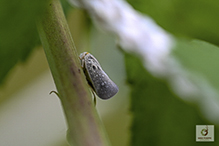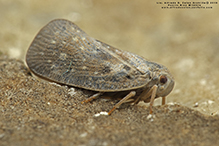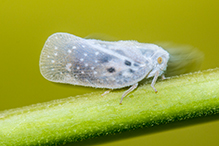citrus flatid planthopper
(Metcalfa pruinosa)
Conservation • Description • Habitat • Ecology • Distribution • Taxonomy
Conservation Status |
|
|||||||
| IUCN Red List | not listed |
|||||||
| NatureServe | not listed |
|||||||
| Minnesota | not listed |
|||||||
Description |
||
Citrus flatid planthopper is a small, jumping insect. It is native and very common in eastern North America. It has been introduced into southern Europe and is now an invasive species of concern in orchards and vineyards there. It feeds on a wide variety of woody species including maple, elm, willow, black locust, dogwood, hawthorn, elder, grape, and raspberry. Adults are 3 ⁄16″ to 5 ⁄16″ long and 1 ⁄16″ to ⅛″ wide at their widest point. The body is flattened laterally. From above it appears wedge-shaped. The color is highly variable, from brown or gray. The wings and body are moderately to densely covered with a mealy, bluish-white, waxy powder. The forewings are elongated-triangular in shape and are held at rest tent-like, almost vertically, over the body. There are two dark spots on the basal half of each forewing. The anal vein is Y-shaped. There are numerous cross veins between the leading edge of the forewing (costa) and the first longitudinal vein (subcosta). The lower (anal) veins are lumpy or knotty (nodal). The compound eyes are yellow or orangish-yellow. The antennae are attached on the sides of the head below the eyes. They are short, bristle-like, and three-segmented. The first segment is small and collar-like. The hind legs are 1½ times as long as the other legs. The fourth segment (tibia) of each hind leg has 5 to 7 comb-like spines at the tip and two spines on the sides. The last part of the leg (tarsus), corresponding to a foot, has three segments. The nymphs are flat, white, and densely covered with white, waxy powder. Waxy filaments at the end of the body usually form two appendages, but these may break off. |
||
Size |
||
3 ⁄16″ to 5 ⁄16″ |
||
Similar Species |
||
Habitat |
||
A wide variety of woody species |
||
Ecology |
||
Season |
||
May to September. One generation per year. |
||
Behavior |
||
It often hops, like a grasshopper, for transportation, but usually walks slowly to avoid detection. |
||
Life Cycle |
||
The female inserts a single egg in a preexisting opening in the bark of a host plant. She sometimes excavates an opening in the bark. She will lay up to 100 eggs. The eggs overwinter and hatch in May the following year. The nymphs pass through five stages (instars) and emerge as adults between July and September. |
||
Nymph Food |
||
|
||
Adult Food |
||
It feeds on a wide variety of woody species including maple, elm, willow, black locust, dogwood, hawthorn, elder, grape, and raspberry. It has been recorded feeding on more than 200 species of plants. In North America it feeds of 34 genera of native plants in 20 families. |
||
Distribution |
||||
|
Sources |
|||
| 7/30/2022 | ||||
Occurrence |
||||
Common and widespread |
||||
Taxonomy |
|||
Order |
Hemiptera (True bugs, Hoppers, Aphids, and Allies) |
||
Suborder |
Auchenorrhyncha (true hoppers) |
||
| Infraorder | Fulgoromorpha (planthoppers) | ||
Superfamily |
Fulgoroidea |
||
Family |
Flatidae |
||
Subfamily |
Flatinae |
||
| Tribe | Nephesini | ||
Genus |
Metcalfa | ||
Subordinate Taxa |
|||
citrus flatid planthopper (Metcalfa pruinosa cubana) citrus flatid planthopper (Metcalfa pruinosa pruinosa) |
|||
Synonyms |
|||
Flata pruinosa Melormenis pruinosa Ormenis pruinosa Poeciloptera pruinosa |
|||
Common Names |
|||
citrus flatid plant hopper citrus flatid planthopper citrus planthopper frosted lightening hopper mealy lantern fly |
|||
Glossary
Costa
On ferns: The central axis of a pinna, to which pinnules are attached. On mosses: the central axis (midvein) of a leaf. On insects: The vein on the leading edge of the forewing.
Instar
The developmental stage of arthropods between each molt; in insects, the developmental stage of the larvae or nymph.
Tergum
The upper (dorsal) surface of a body segment of an arthropod. Plural: terga.
Tibia
The fourth segment of an insect leg, after the femur and before the tarsus (foot). The fifth segment of a spider leg or palp. Plural: tibiae.
visitor Photos |
|||||
Share your photo of this insect. |
|||||
| This button not working for you? Simply email us at info@MinnesotaSeasons.com. Attach one or more photos and, if you like, a caption. |
|||||
Mike Poeppe |
|||||
 |
|||||
Alfredo Colon |
|||||
 |
 |
||||
MinnesotaSeasons.com Photos |
|||||
 |
|||||

Slideshows |
||

visitor videos |
|||
Share your video of this mammal. |
|||
| This button not working for you? Simply email us at info@MinnesotaSeasons.com. Attach a video, a YouTube link, or a cloud storage link. |
|||
@annahalo |
|||
| Citrus flatid planthopper (Metcalfa pruinosa)! Aug 28, 2023 |
|||
About
Citrus flatid planthopper (Metcalfa pruinosa)! #shorts @annahalo Thank you to all my Fans and Friends! |
|||
| Mystery White Bug? Aug 16, 2023 |
|||
About
Mystery White Bug? #shorts @annahalo Thank you to all my Fans and Friends! |
|||
Other videos |
|||
| Citrus Flatid Planthopper (Flatidae: Metcalfa pruinosa) Lateral view Carl Barrentine |
|||
About
Uploaded on Aug 10, 2011 Photographed at Fisher, Minnesota (10 August 2011). Thank you to Andy Hamilton (@Bugguide.net) for confirming the identity of this specimen! |
|||
| Metcalfa pruinosa MICROinACTION |
|||
About
Published on Sep 26, 2012 The adults reach approximately 4-7 millimetres of length and can mostly encountered from mid-July until late autumn. Gli adulti raggiungono approssimativamente i 4-7 millimetri di lunghezza e possono maggiormente essere incontrati dalla metà di Luglio fino al tardo autunno. |
|||
| Citrus Flatid Planthopper seahue |
|||
About
Published on Jul 31, 2011 planthopper |
|||
| Προσβολή δένδρου λωτού από Metcalfa pruinosa (Say) Pomology Institute |
|||
About
Published on Oct 20, 2015 Προσβολή δένδρου λωτού από Metcalfa pruinosa (Say). Google translation: Infringement lotus tree from Metcalfa pruinosa (Say). |
|||


Last Updated:



